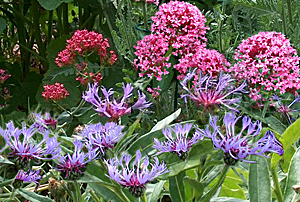 The beauty of the combination lies in finding just the right color echo by matching the crimson red of the Jupiter’s beard to the red center of the perennial cornflower. Both flowers are somewhat variable in color so this is not a combination for the impatient gardener. Once found, however, the pair offers subtle beauty and great satisfaction. This combination works best in cool climates because neither the Jupiter’s beard and perennial cornflower grow well in heat and humidity. Given the right climate they bloom together well into the summer. Both plants like full sun to light shade, and average, medium-moist well drained soil.
The beauty of the combination lies in finding just the right color echo by matching the crimson red of the Jupiter’s beard to the red center of the perennial cornflower. Both flowers are somewhat variable in color so this is not a combination for the impatient gardener. Once found, however, the pair offers subtle beauty and great satisfaction. This combination works best in cool climates because neither the Jupiter’s beard and perennial cornflower grow well in heat and humidity. Given the right climate they bloom together well into the summer. Both plants like full sun to light shade, and average, medium-moist well drained soil.
 Jupiter’s Beard (Centranthus ruber var. coccineus)
Jupiter’s Beard (Centranthus ruber var. coccineus)
Also called red valerian, Jupiter’s beard is a bushy perennial native to the Mediterranean. The small flowers are held in dense clusters on top of well branched stems and have a pleasant but light fragrance. The leaves are blue-gray. Plants self-sows and may be found in many out of the way places. They like alkaline soils and are often found growing in limestone mortar.
Bloom time:
-
- Late Spring to fall
Size:
-
- 18-36” H x 24” W
Hardiness:
- Zones 5-8
 Perennial Cornflower (Centaurea montana)
Perennial Cornflower (Centaurea montana)
The spidery flower heads of perennial cornflower are unique and memorable. They are two to three inches across and are composed of violet-blue ray flowers surrounding a center of dark reddish-violet disc flowers. The tips of the ray flowers are divide into several segments that give the flowerheads a frilly, delicate appearance. The flower heads are surrounded with a lovely involucres composed of overlapping bracts each edged with a black margin. The stems are unbranched and the foliage is silvery gray-green. If perennial cornflowers likes its site it can become a wanderer with its numerous stolons advancing throughout the garden.
Bloom Time:
-
- Late spring to mid-summer
Size:
-
- 24” h x 24” W
Hardiness:
- Zones 4-8
